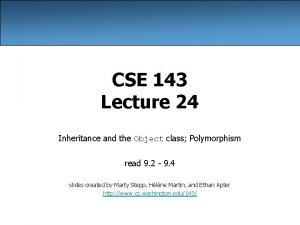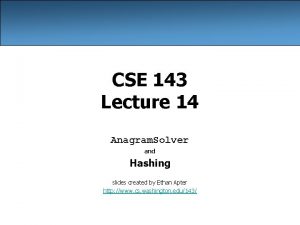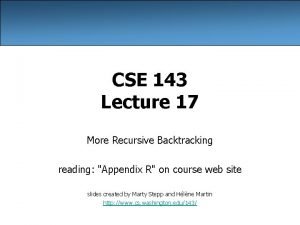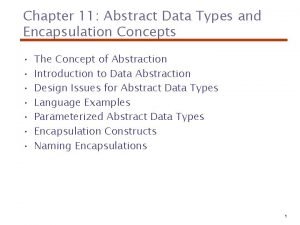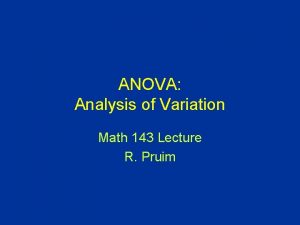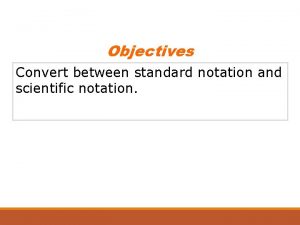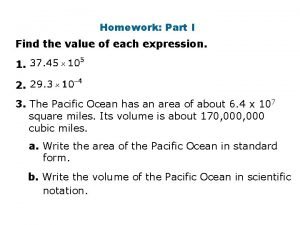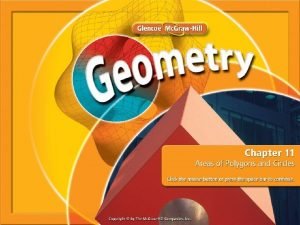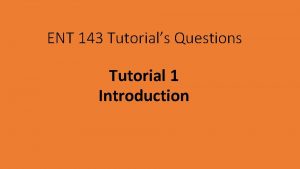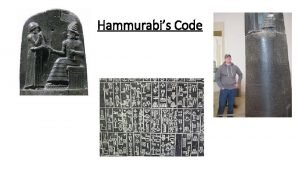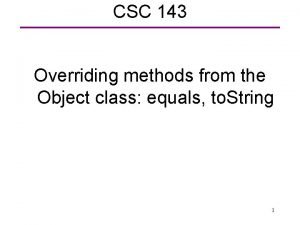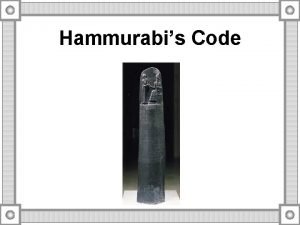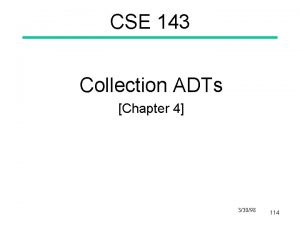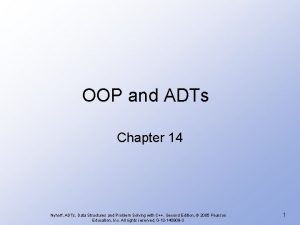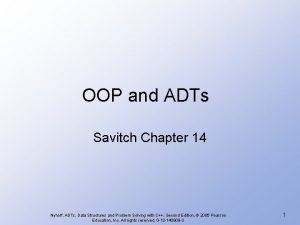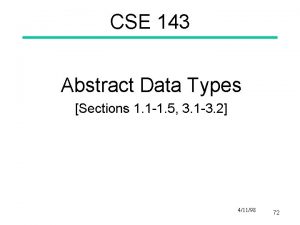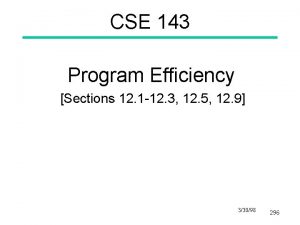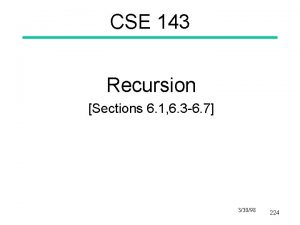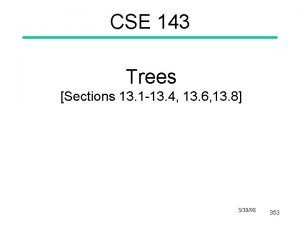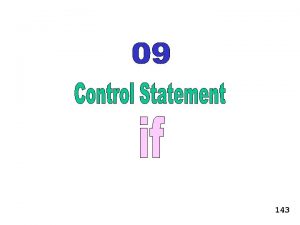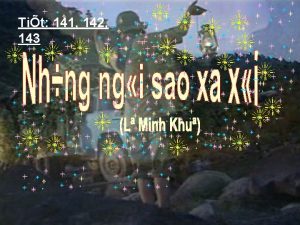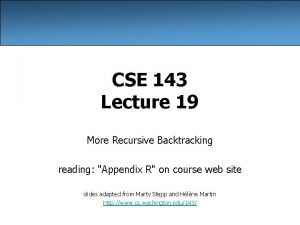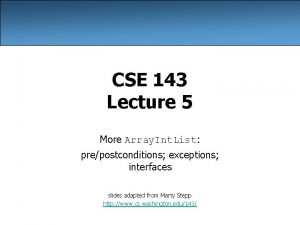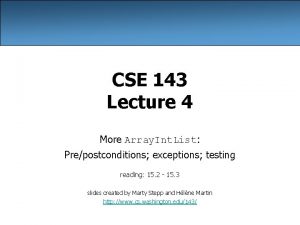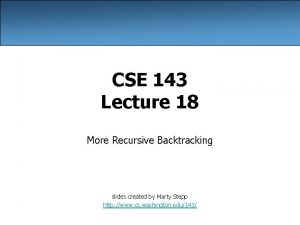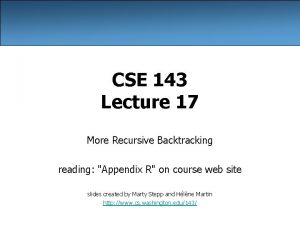CSE 143 More Collection ADTs Sections 4 6
![CSE 143 More Collection ADTs [Sections 4. 6 -4. 8] 3/30/98 131 CSE 143 More Collection ADTs [Sections 4. 6 -4. 8] 3/30/98 131](https://slidetodoc.com/presentation_image/de75fc91b40923f25843aad80491e77e/image-1.jpg)




























- Slides: 29
![CSE 143 More Collection ADTs Sections 4 6 4 8 33098 131 CSE 143 More Collection ADTs [Sections 4. 6 -4. 8] 3/30/98 131](https://slidetodoc.com/presentation_image/de75fc91b40923f25843aad80491e77e/image-1.jpg)
CSE 143 More Collection ADTs [Sections 4. 6 -4. 8] 3/30/98 131

More Collection ADTs ·We’ll study the following “classic” ADTs ¥Stack: ordered collection accessible in LIFO manner ¥Queue: ordered collection accessible in FIFO manner ¥Set: unordered collection without duplicates ¥Table: unordered mapping of keys to values (e. g. names -> Student. Records) ·We’ll spend much of the rest of the quarter discussing various implementation techniques ¥Those techniques can then be used with every more complicated data structures. 3/30/98 132

Stack ADT ·Top: Uppermost element of stack, top . . . first to be removed ·Bottom: Lowest element of stack, last to be removed ·Height or Depth: Number of elements ·Elements are always inserted and removed from the top (LIFO) ·Homogeneous collection bottom a. Stack: 3/30/98 133

Stack Operations ·push(item): Adds an element to top of stack, increasing stack height by one ·pop(): Removes topmost element from stack and returns it, decreasing stack height by one ·top(): Returns a copy of topmost element of stack, leaving stack unchanged ·No cursor ·No iteration via reset(), advance(), etc. 3/30/98 134

Stack Example ·Show the changes to the stack in the following example: Stack s; s. push(5); s. push(3); s. push(9); int v 1 = s. pop(); int v 2 = s. top(); s. push(6); s. push(4); 3/30/98 135

Common Uses of Stacks ·Implementing function calls ·Postfix notation ¥ 4 7 + 5 * instead of (4 + 7) * 5 ¥push operands until operator found, pop 2 values, apply operator, push result ·Backtracking, e. g. , to explore paths through a maze 3/30/98 136

Stack Interface class Int. Stack { public: Int. Stack(); bool is. Empty(); bool is. Full(); void push(int item); int pop(); int top(); private: . . . } // // // is the stack empty? is the stack full? add item to top remove top item show the top item 3/30/98 137

A Stack Client // Read numbers and print in reverse order void Reverse. Numbers() { Int. Stack s; int one. Number; while ( cin >> one. Number ) { assert ( !s. Is. Full() ); s. push(one. Number); } while ( !s. Is. Empty() ) cout << s. pop() << endl; } 3/30/98 138

Possible Implementations ·Many possible implementations ¥Array-based ¥Dynamic memory structure (later) ¥List-based ·As implementor, use other ADTs to make job easier ¥Don’t reinvent the wheel for every problem ¥Often simplifies job to reuse pieces when possible 3/30/98 139

Stack Interface ·We’ll use a hidden list. #include “Int. List. h” class Int. Stack { public: Stack(); bool is. Empty(); bool is. Full(); void push(int item); int pop(); int top(); private: Int. List items; } // // // is the stack empty? is the stack full? add item to top remove top item show the top item 3/30/98 140

Stack Implementation (2) Int. Stack: : Int. Stack() { } // don’t need to do anything, why? bool Int. Stack: : is. Full() { return items. is. Full(); } bool Int. Stack: : is. Empty() { return items. is. Empty(); } 3/30/98 141

Stack Implementation (3) void Int. Stack: : push(int item) { items. insert. Before(item); } int Int. Stack: : pop() { int rval = items. data(); items. delete. Item(); return rval; } int Int. Stack: : top() { return items. data(); } 3/30/98 142

Queue ADT ·Homogeneous, ordered collection, accessed only at the front (removal) and rear (insertion) ·Front: First element in queue ·Rear: Last element of queue ·FIFO: First In, First Out a. Queue: . . . front rear 3/30/98 143

Queue Operations ·enqueue(item) : Adds an element to rear of queue ·dequeue() : Removes and returns element at the front of queue ·front() : Returns a copy of the front element of queue ·No cursor ·No iteration via reset(), advance(), etc. 3/30/98 144

Queue Example ·Show the changes to the queue in the following example: Queue q; q. enqueue(4); q. enqueue(7); q. enqueue(5); int v 1 = q. dequeue(); int v 2 = q. front(); q. enqueue(9); q. enqueue(2); 3/30/98 145

Common Uses of Queues ·Managing a first-come, first-serve line ¥Processes in an operating system ¥Print jobs at the printer ·Buffering input/output ¥When printing to screen with cout, characters don’t appear right away: they are buffered and sent out in groups. ¥Mouse events ·Simulations ¥People waiting in line for service 3/30/98 146

Queue Interface class Int. Queue { public: Int. Queue(); bool is. Full(); bool is. Empty(); void enqueue(int item); int dequeue(); int front(); private: Int. List items; // again, we’ll use a hidden list } 3/30/98 147

Queue Implementation (1) Int. Queue: : Int. Queue() { } bool Int. Queue: : is. Full() { return items. is. Full(); } bool Int. Queue: : is. Empty() { return items. is. Empty(); } void Int. Queue: : enqueue(int item) { while (!items. end. Of. List()) items. advance(); items. insert. Before(item); } 3/30/98 148

Queue Implementation (2) int Int. Queue: : dequeue() { items. reset(); int rval = items. data(); items. delete. Item(); return rval; } int Int. Queue: : front() { items. reset(); return items. data(); } 3/30/98 149

Set ADT ·Attributes of set type ¥Nonlinear collection of elements ¥Varying number of elements ¥No duplicates ·Operations on sets ¥Element operations: add, remove, is. Member ¥Aggregate operations: union, intersection, difference ¥Possibly Iteration: reset, advance, end, data 3/30/98 150

Set Terminology ·Union: Create a new set whose elements are those found in either set ·Intersection: Create a new set whose elements are those found in both sets ·Difference: Remove elements found in one set from other set a. Set: 7 23 4 1 3 9 6 10 8 3/30/98 151

Set Examples ·Show the changes to the sets in the following example Set s 1, s 2; s 1. add(4); s 1. add(8); s 1. add(14); s 2. add(3); s 2. add(4); s 2. add(5); Set s 3 = s 1. union(s 2); Set s 4 = s 1. intersection(s 2); Set s 5 = s 1. difference(s 2); 3/30/98 152

Set Interface class Int. Set { Int. Set(); // standard size(), is. Full(), is. Empty() methods bool is. Member(int item); void add(int item); void remove(int item); Set union(Set other); Set intersection(Set other); Set difference(Set other); // iteration member functions here. . . private: Int. List items; // again, we’ll use our trusty } // Int. List 3/30/98 153

Table ADT ·Attributes of table type ¥Set of key/value pairs ¥No duplicate keys ·Operations on tables ¥lookup value from key ¥insert value at key ¥remove key and associated value from table ·Uses: ¥Phone book, class roster, book index, databases ·Sometimes also called a dictionary 3/30/98 154

Table Terminology ·Key: Portion of pair used to look up data, like an index (aka domain value) ·Value: Portion of pair that contains data (aka range value) a. Table: “ 4476542 K” “ 3828122 E” “ 24601 JVJ” “ 994802 WE” “ 8675309 A” Key (employee ID) 23, 440 27, 640 15, 203 45, 210 28, 776 Value (salary) 3/30/98 155

Example of Operations // phone book example: Table pb; pb. insert(“Julie”, 5552345); pb. insert(“Bob”, 3450011); pb. insert(“Bart”, 6661212); int barts. Number = pb. lookup(“Bart”); pb. delete(“Bob”); 3/30/98 156

Table Interface class Table { public: Table(); // Create new table int size(); // Return size of table bool is. Empty(); // Is table empty? bool is. Full(); // Is table full? Range. Type lookup(Domain. Type key); void insert(Domain. Type key, Range. Type value); Range. Type remove(Domain. Type key); }; private: . . . 3/30/98 157

Table Implementation ·Many different possibilities ¥Array of structs ¥List of structs ¥Dynamic memory structure ·Implementations may make use of future topics ¥Searching, sorting ¥Hash tables ·No implementation details at this time. . . 3/30/98 158

Summary ·Stack ¥List with LIFO structure ¥Access via push(item), pop(), and top() ·Queue ¥List with FIFO structure ¥Access via enqueue(item), dequeue(), and front() ·Set ¥Unordered collection, without duplicates ·Table ¥Unordered association of key-value pairs ¥Access via insert(key, value), delete(key), lookup(key) 3/30/98 159
 Lirik lagu more more more we praise you
Lirik lagu more more more we praise you More more more i want more more more more we praise you
More more more i want more more more more we praise you Cse 143
Cse 143 Cse 143
Cse 143 Cse 143
Cse 143 Adts ukiah
Adts ukiah Adts, data structures, and problem solving with c++
Adts, data structures, and problem solving with c++ Parameterized abstract data types
Parameterized abstract data types Parameterized abstract data types
Parameterized abstract data types Landsat collection 1 vs collection 2
Landsat collection 1 vs collection 2 Clean collection vs documentary collection
Clean collection vs documentary collection Air canada flight 143
Air canada flight 143 Anova math
Anova math Alan ableson queens
Alan ableson queens 143 000 in scientific notation
143 000 in scientific notation 143.ent
143.ent Biostats usmle
Biostats usmle 143/100 simplified
143/100 simplified 427 000 in scientific notation
427 000 in scientific notation Salmo 143:2
Salmo 143:2 11-1 area of parallelograms and triangles
11-1 area of parallelograms and triangles 143 ent
143 ent Melodia do salmo 143 bendito seja o senhor meu rochedo
Melodia do salmo 143 bendito seja o senhor meu rochedo Pg 143
Pg 143 Hammurabis code 143
Hammurabis code 143 Let the holy spirit guide you
Let the holy spirit guide you Csc 143
Csc 143 Sp 143 warszawa
Sp 143 warszawa Accretion expense
Accretion expense Hammurabis code 143
Hammurabis code 143


